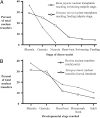The first half-century of nuclear transplantation
- PMID: 12821779
- PMCID: PMC166179
- DOI: 10.1073/pnas.1337135100
The first half-century of nuclear transplantation
Abstract
Fifty years after Briggs and King first succeeded in obtaining normal tadpoles from transplanted embryo nuclei in vertebrates, two general principles have emerged from work in amphibia and mammals. One is the conservation of the genome during cell differentiation. A small percentage of adult or differentiated cells have totipotent nuclei, and a much higher percentage of cells committed to one pathway of cell differentiation have multipotent nuclei. The other is the remarkable reprogramming capacity of cell, and especially egg, cytoplasm. The eventual identification of reprogramming molecules and mechanisms could facilitate a route toward cell replacement therapy in humans.
Figures



References
-
- Weismann, A. (1893) The Germ-Plasm: A Theory of Heredity (Walter Scott Ltd., London).
-
- Spemann, H. (1938) Embryonic Development and Induction (Yale Univ. Press, New Haven, CT).
-
- Comandon, J. & de Fonbrune, P. (1939) C. R. Seanc. Soc. Biol. 130 740-748.
-
- Hammerling, J. (1934) Arch EntwMech. Org. 132 424-462. - PubMed
Publication types
MeSH terms
Grants and funding
LinkOut - more resources
Full Text Sources
Other Literature Sources
Medical

